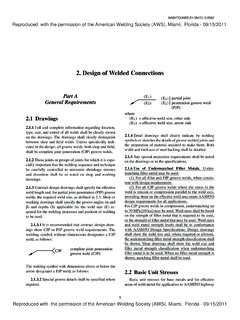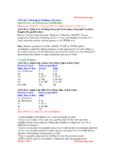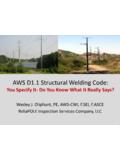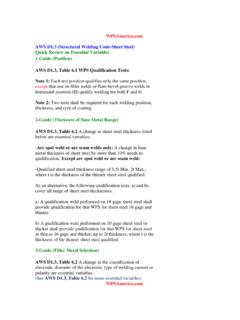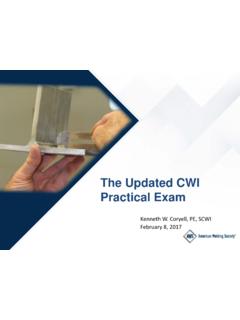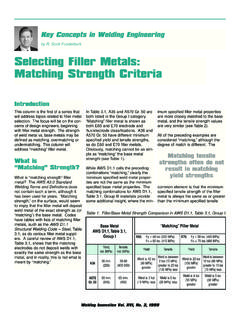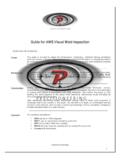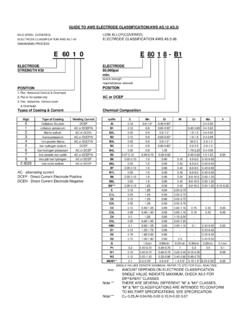Transcription of 7. Stud Welding - AWS Section
1 155 AASHTO/AWS ScopeSection 7 contains general requirements for weldingsteel studs to steel (see and for approvedsteels). In addition, it stipulates specific requirements forthe following:(1) Workmanship, preproduction testing, operatorqualification, and application qualification testing, whenrequired, all to be performed by the Contractor(2) QC and QA inspection of stud Welding duringproduction(3) Mechanical properties of steel studs, and require-ments for qualification of stud bases, all tests and docu-mentation to be furnished by the stud General shall be of suitable design for arc Welding tosteel members with the use of automatically timed studwelding equipment.
2 The type and size of the stud shall beas specified by the drawings, specifications, or specialprovisions. For headed-type studs, see Figure arc shield (ferrule) of heat-resistant ceramic orother suitable material shall be furnished with each suitable deoxidizing and arc stabilizing flux forwelding shall be furnished with each stud of 8 mm [5/16 in.]diameter or larger. Studs less than 8 mm [5/16 in.] in diam-eter may be furnished with or without studs with qualified stud bases shall be stud base, to be qualified, shall have passed the testdescribed in Annex VI. The arc shield used in productionshall be the same as used in qualification tests or asrecommended by the manufacturer.
3 Qualification of studbases in conformance with Annex VI shall be at themanufacturer s shall be produced by heading, rolling, ormachining. Finished studs shall be of uniform qualityand condition, free of injurious laps, fins, seams, cracks,twists, bends, or other injurious discontinuities. Radialcracks or bursts in the head of a stud shall not be causefor rejection, provided that the cracks or bursts do notextend more than half the distance from the headperiphery to the shank, as determined by : Heads of shear connectors or anchor studs aresubject to cracks or bursts, which are names for the samething.
4 Cracks or bursts designate an abrupt interruptionof the periphery of the stud head by radial separation ofthe metal. Such interruptions do not adversely affect thestructural strength, corrosion resistance, nor other func-tional requirements of headed bases qualified under Annex VI shall be requested by the Engineer, the Contractor shallprovide the following information:(1) A description of the stud and arc shield(2) Certification from the manufacturer that the studbase is qualified as described in (3) Qualification test (M270) Grades 690/690W (100/100W)(A 709M [A 709] Grades 690/690W [100/100W])
5 Steelsshall not be stud welded without approval of the Mechanical shall be made from cold-drawn bar stockconforming to the requirements of ASTM A 108, Speci-fication for Steel Bars, Carbon Cold Finished, StandardQuality Grades, Grades G10100 through G10200, inclu-sive, either semi-killed or killed property requirements of studsother than outlined below shall be specified by the manufacturer s option, mechanicalproperties of studs shall be determined by testing either7. Stud WeldingReproduced with the permission of the American Welding Society (AWS), Miami, Florida - 09/15/2011 Reproduced with the permission of the American Welding Society (AWS), Miami, Florida - 09/15/2011 AASHTO/AWS :2002 STUD WELDING156(1) the steel after cold finishing, or (2) the full diameterfinished studs.
6 In either case, the studs shall conform tothe requirements shown in Table properties shall be determined in con-formance with the applicable sections of ASTM A 370,Test Methods and Definitions for Mechanical Testing ofSteel Products. A typical test fixture is used, similar tothat shown in Figure request by the Engineer, the Contractor shallfurnish the Contractor shall provide the stud manu-facturer s certification that the studs, as delivered, con-form to the applicable requirements of and Contractor shall provide certified copiesof the stud manufacturer s test reports covering the lastcompleted set of in-plant quality control mechanicaltests, required by for each stock size delivered.
7 Thequality control test shall have been made within the sixmonth period before delivery of the quality control tests are not available, theContractor shall furnish mechanical test reports conform-ing to the requirements of The mechanical tests shallbe on finished studs provided by the manufacturer of thestuds. The number of tests to be performed shall be spec-ified by the Engineer may select studs of each type andsize used under the contract as necessary for checkingthe requirements of and Furnishing these studsshall be at the Contractor s expense. Testing shall be atthe Owner s the time of Welding , the studs shall be free fromrust, rust pits, scale, oil, moisture, and other deleteriousmatter that would adversely affect the Welding stud base shall not be painted, galvanized, norcadmium-plated prior to areas to which the studs are to be welded shallbe free of scale, rust, moisture, and other injurious mate-Note:1.
8 L = manufactured length length specified by Engineer plusupset Dimension and Tolerances of Standard-Type Shear Connectors (see )Standard Dimensions, mm [in.]Shank Diameter(C)Length Tolerance(L)HeadDiameter(H)MinimumHead Height(T) [1/2]+ [ ] [ 1/16] [1 1/64] [9/32] [5/8]+ [ ] [ 1/16] [1-1/4 1/64] [9/32] [3/4]+ [ ] [ 1/16] [1-1/4 1/64] [3/8] [7/8]+ [ ] [ 1/16] [1-3/8 1/64] [3/8] [1]+ [ ] [ 1/16] [1-5/8 1/64] [1/2]Table Property Requirements for Studs (see )Ty pe A1 Type B2 Tensile strength380 MPa[55 ksi] min415 MPa[60 ksi] minYield strength ( offset) 345 MPa[50 ksi] minElongation(% in 50 mm [2 in.)]
9 ])17% min20% minReduction of area50% min50% minNotes:1. Type A studs shall be general purpose of any type and size used forpurposes other than shear transfer in composite beam design Type B studs shall be studs that are headed, bent, or of other con-figuration in 12 mm [1/2 in.] through 23 mm [7/8 in.] diameter thatare used as an essential component in composite beam design with the permission of the American Welding Society (AWS), Miami, Florida - 09/15/2011 Reproduced with the permission of the American Welding Society (AWS), Miami, Florida - 09/15/2011157 STUD WELDINGAASHTO/AWS :2002rial to the extent necessary to obtain satisfactory areas may be cleaned by wire brushing, scaling,prick-punching, or grinding.
10 Extreme care should be ex-ercised when Welding through metal arc shields or ferrules shall be kept dry. Anyarc shields which show signs of surface moisture fromdew or rain shall be oven dried at 120 C [250 F] for twohours before and lateral spacings of stud shear con-nectors (type B) with respect to each other and to edgesof beam or girder flanges may vary a maximum of 25 mm[1 in.] from the location shown in the drawings. Theclear distance between studs shall not be less than 25 mm[1 in.] unless approved by the Engineer. The minimumdistance from the edge of a stud base to the edge of aflange shall be the diameter of the stud plus 3 mm [1/8 in.]
